Summary
Today in the 21st century, with the continuous development and progress of society, people's scientific understanding of information has developed from low level to high level, from the original perceptual understanding to rational understanding. The importance of management work has gradually been recognized by people. It is understood that scientific management can make information storage accurate, fast and complete, and can improve the efficiency of work management and promote its development.
The paper mainly introduces the university sports venue reservation system , including the current status of the research and the development background involved. Then it also discusses the design goals of the system, the system requirements, the entire design plan, and the impact of the system on The design and implementation were also discussed in detail. Finally, some specific tests were conducted on the university stadium reservation system .
This article uses Java as development technology to implement a university sports venue reservation system . The main functions of the university sports venue reservation system include: administrator: home page, personal information, public management (carousel chart, announcement information) user management (administrator, faculty, student users, ordinary users) venue center, employee orders, Student orders, order information, equipment information, and financial information functions basically realize the entire process of the university sports venue reservation system .
Specifically, in terms of system design, the B/S structure is adopted. At the same time, Java technology is also used to design the dynamic page. The Mysql database is used in the background. It is a very excellent university sports venue reservation system .
Keywords :University stadium reservation system; Java technology; Mysql database; B/S structureSSM framework
Abstract
Today in the 21st century, with the continuous development and progress of society, people's understanding of information science has developed from low level to high level, from the original perceptual knowledge to rational knowledge, and the importance of management has gradually been recognized by people. Scientific management can make information storage accurate, fast and perfect, and can improve the efficiency of work management and promote its development.
The paper mainly introduces the university sports venue reservation system, including the current situation of the research and the development background involved, and then discusses the design objectives of the system, the system requirements, and the entire design scheme. The design and implementation of the system are also discussed in detail. Finally, some specific tests are carried out on the university sports venue reservation system.
This paper uses Java as the development technology to implement a university sports venue reservation system. The main functions of the university sports venue reservation system include: administrator: home page, personal information, public management (broadcast map, announcement information) user management (administrator, faculty, student user, ordinary user) venue center, staff order, student order, order information, equipment information, and financial information functions, basically realizing the whole process of the university sports venue reservation system.
In terms of system design, the B/S structure is adopted. At the same time, Java technology is also used to design on the dynamic page. MySQL database is used on the background. It is a very excellent university sports venue reservation system.
Key words: university sports venue reservation system; Java technology; MySQL database; B/S structure SSM framework
Table of contents
1.1 Background and significance of the topic
1.2 Research status at home and abroad
2 System development environment
3.2.1 System development process
3.2.3 System operation process
3.2.6 Information deletion process
3.3.1 Administrator use case diagram
4.3.1 Database design principles
5 system interface implementation
5.2 Administrator function module
5.2.4 Carousel image management
5.2.5 Employee order management
5.2.6 Equipment information management
5.2.7 Financial information management
5.3 Front page function module
5.3.1 User login, user registration
5.3.3 Place an order at a venue
1 Overview
1.1 Background and significance of the topic
With the development of modern network technology, the design of university sports venue reservation systems is now in the development stage, so the requirements are relatively strict. The development method of the system must be formulated and developed based on the functions of the system and the actual needs of users . Relying on the rapid development of network technology and the combination of modern communication technology to bring convenience to people, it can facilitate users to view online, and can also realize processes such as online university stadium reservation systems through these technologies . In today's society, the Internet is developing rapidly, and university stadium reservation systems are also developing explosively in China. This network model has had a profound impact on society that has long used the Internet. In this social environment, the development prospects of developing a simple and convenient university stadium reservation system that can be operated by all users are very good.
In the past, information management related to the reservation system of university sports venues was done manually by staff. This method is not only timely but also inconvenient when searching and changing. With the advancement of science, the maturity of technology, and the rapid development of computer informatization, society has also gained a profound understanding that computers are very powerful. Computers have entered various fields of the development of human society and play a very important role. This system uses network communication and computer information storage and management, and has advantages that cannot be replaced by traditional methods. For example, the calculation and retrieval speed is extremely fast, the reliability is extremely high, the storage capacity is extremely large, the confidentiality is extremely good, the storage time is extremely long, and the cost is extremely low. In terms of work efficiency, it can be greatly improved, and there will also be good gains when extended to service levels. With the Internet, the management of all aspects of the university sports venue reservation system is more scientific and systematic, more standardized and simpler.
1.2 Research status at home and abroad
With the continuous penetration of computer networks, the way people live, work, and study is slowly changing. Traditional information management methods related to university sports venue reservation systems generally adopt manual methods, and the acquisition, organization, modification, and storage of information are still in the manual stage. On the one hand, this method requires a lot of manpower, material resources and money, is difficult to interact with, and wastes time; on the other hand, the management of user and other information, especially as the number of users increases, is particularly difficult to query and modify. ; Finally, due to the continuous increase of users and other information, the storage of information has also become a problem.
In some developed countries, the Internet has developed relatively quickly and has largely completed the transition from manual to computer management. Computer application in our country started relatively late, and the development regions are unbalanced. There are still many regions or units using traditional methods for management. However, computers are developing rapidly, including the popularization of the Internet. Many units and users are slowly beginning to come into contact with network management. system. Looking at these systems, they mainly have the following characteristics:
(1)Advancement: realize network management.
(2) Versatility: It can basically be used in the same industry.
(3) Convenience: Management work can be completed through the Internet.
(4) Timeliness: Information is updated in a timely manner.
( 5 ) Scalability: Modules can be added as needed.
( 6 ) Security: Encrypt user and other information.
Up to now, the Internet has penetrated deeply into people's lives. Smartphones, laptops, etc. have become people's main tools for obtaining information. This is an era of unlimited communication. Therefore, using the Internet to manage university stadium reservation systems has also become a general trend. Therefore, developing a university stadium reservation system is a must.
1.3 Main work of this topic
At the beginning, this article gives an overall description of the basic knowledge discussed in the system, and conducts a system analysis on this basis. In order to enable this system to be designed and implemented in a better and more complete manner, analysis and investigation must be conducted first. Based on the previous related foundations, a detailed analysis of the new system was carried out in terms of functionality. Then through detailed analysis, system design was carried out. Secondly, in terms of the feasibility of system implementation, I chose Java technology for development and design. For data storage, I used Mysql database for design. Since both Java and Mysql are very mature, they are very reliable, safe and practical in all aspects. Finally, the system is tested, perfected and released.
2 System development environment
2.1 Introduction to Java
Java technology is a server language that is easy to learn and use. It requires very little knowledge in the programming process to build a truly interactive site. For this tutorial, it does not require you to fully understand the language, as long as you can quickly integrate into the web site, and you can also perform some basic knowledge of programming.
In modern society, the use of Java language to create dynamic web pages is the most commonly used, mainly because Java is relatively simple and easy to understand, and users can write scripts on the web server. Java language technology has certain security and cross-platform functions in programming technology, and it can directly support distributed network applications and efficiency. Its function is convenient and simple in Java language technology. For this language technology, it is like a kaleidoscope. During development, it can be randomly combined and finally become petals of different colors. With the rapid development of the Internet and the continuous development of e-commerce, computers have begun to be applied to facilities in all walks of life. The traditional management methods and user needs in the past cannot meet the current normal supply and demand relationship, so we must Meet user needs by adding today's new technologies . From the current point of view, Java technology has been widely used in dynamic web pages.
The Java language has a variety of features: (1) Cross-platform independence; (2) Object-oriented; (3) Security is guaranteed; (4) Supports multiple tasks; (5) Multiple writing methods, code writing Simple. Compared with other low-level languages and high-level languages, the Java language has obvious advantages and broad prospects in the future. It can be widely used in personal laptops, big data, large-scale games, etc.
The Java language is object-oriented and easy to understand. Regarding objects, it can actually be understood that every thing is an object, including us humans. Utilize the basic characteristics of object-oriented languages to solve practical problems in software development and provide technical support for effective software development.
2. 2 Mysql database
Mysql is a multi- user , multi-thread server that uses SQL database. The database management system is based on the relationship between SQL users and server modes. Its advantages include powerful functions, simple operation, convenient management, reliability and security, and fast operation. , multi-threading, cross-platform, fully networked, stable, etc., it is very suitable for the development of Web sites or other application software in the database back-end. In addition, using many languages, users can write and access MySQL database programs. Mysql database is also open source. Developers are increasingly fond of using Mysql relational database, and its application scope has also been extended. Because of its speed and ease of use, it is also used in the development of database backends for Web sites or application software.
The mysql database has many advantages, such as its easy-to-understand operation, powerful functions, and high information storage capacity. Therefore, it is widely used by people. For mysql database, it is generally mainly used for encoding and querying data, and it is applied to this database in many designs. In this process, we can query and combine conventional data, so When we use the mysql database, we only need to write a small piece of data to achieve the corresponding function. A database is a storage room for data storage, but the data is stored on a computer instead of a real storage room. The data is stored in a fixed format, not disordered. The definition is: a fixed format for a long time. Storage on computer memory that can be shared. Database management mainly includes the establishment of data tables, data storage, modification and addition of data. In order to ensure that the database system can operate normally, the management work carried out by relevant personnel. The establishment of the data table can adjust the data in the data table, recombine and reconstruct the data to ensure the security of the data.
2. 3 B/S structure
The BROWSER/SERVER program architecture uses various browsers installed on the computer to access and use it. Compared with the C/S program structure, it can be used directly without the need for program installation. The way the BROWSER/SERVER architecture works is to install one on a remote server and then access and use it on any computer connected to the Internet. The development method of BROWSER/SERVER architecture brings great convenience to users , and the developed program system can be used at any time and place.
In the B/S structure, users can access and use the functions of the system website anywhere with access to the Internet. There are no restrictions on region or time. The B/S structure places the program completely on the server of the computer network. The computer Internet provides users with remote network services. In the B/S system with a three-tier architecture, users can make requests to many servers through the browser. The B/S system will greatly reduce the workload. Users only need to install and run fewer client terminals. A large amount of work will be undertaken by the server. In addition, the server also completes work including accessing the database, executing application programs, etc.
The B/S structure mainly has three layers, namely data layer, control logic layer and view layer. Through the view layer, the user allows the control layer to call the data of the data layer, thereby achieving the entire access process. The three layers are independent of each other, easy to maintain and safe to use. The three layers call each other to improve efficiency.
2.4 SSM framework
Today's popular " SSM combination framework" is the abbreviation of Spring + SpringMVC + MyBatis , which is sought after by many. "Combined SSM framework" is a team spirit of strong alliances, each performing its own duties, and coordination and complementation. A framework for web projects, usually simpler data sources. Spring is a lightweight inversion of control framework (IoC) , but it is also an surface-oriented container (AOP) . SpringMVC is often used in the classified working mode of the controller, which is separated from the model object, and the function of the program object is processed with the ATM. This decoupled treatment makes it easier to personalize the entire system. MyBatis is a good sustainability framework that supports ordinary SQL queries while allowing advanced mapping of stored procedures for data optimization. Large-scale Java Web applications have problems due to high development costs, difficulty in maintenance after development, and some difficult problems to solve during the development process. The " SSM Combination Framework" is adopted, which allows the establishment of a business hierarchy and provides a good solution to this problem. .
3 System analysis
The so-called system analysis means that demand personnel obtain information through communication with users , and then display this information to users and developers in the form of demand specifications. In the long history of the development of software functions, for a long time, especially in the beginning, the importance of requirements analysis was not recognized by people. For example, at that time, the American company IBM developed an information management system for British Telecom. Development started without clarity, and the initial construction period was one year. Due to unclear requirements, the construction period was delayed by more than half a year, causing huge losses. This situation also exists in many of our software companies. They develop while developing, and even without clear communication with users , they directly copy the same type of projects and make changes. As a result, changes are made again when the system is accepted, resulting in a loss of manpower and material resources. A huge waste. The reason for all these consequences is that the demand acquisition is not timely, unclear, and incomplete.
3.1 Feasibility analysis
The main goal of the university sports venue reservation system is to achieve homepage, personal information, public management (carousel pictures, announcement information) user management (administrators, faculty, student users, ordinary users) venue center, employee orders, student orders, order information , equipment information, financial information, system management related information management services. After determining the goals, we conduct a feasibility analysis on whether the goals of this system can be achieved from the following four aspects.
3.1.1 Technical feasibility
The university sports venue reservation system mainly uses Java technology, based on B/S structure and Mysql database. The development of applications requires complete functions, simple use, and the establishment of a database with complete, safe and stable data. The development technology of the university stadium reservation system is highly feasible, and the developers have mastered certain development technologies, so the development of the system is feasible.
3.1.2 Operational feasibility
The login interface of the university sports venue reservation system is simple and easy to operate. It uses a common interface window to log in to the interface and perform access operations through a computer. Users can access the system as long as they have used computers. The development of this system uses Java language and is based on B/S structure. These development environments make the system more complete. This system has the characteristics of easy operation, easy management, good interactivity, and is very simple in operation. Therefore this system can be developed.
3.1.3 Economic feasibility
The university sports venue reservation system is based on the B/S model and uses the Mysql database to store data. The required hardware and software environment are required. Program development is mainly the development and maintenance of the management system. Therefore, the program does not require high development manpower and financial resources, and the system is not very complex, the development cycle is short, and it has high economic feasibility.
3.1.4 Legal feasibility
This university sports venue reservation system is a self-designed management system and has great practical significance. Because both the software and the database use open source code, the development and design of this system does not have problems such as infringement and is completely legally feasible.
In summary, the university sports venue reservation system is technically, economically, operationally and legally feasible, and it is feasible to develop this program.
3.2 System process analysis
3.2.1 System development process
When developing the university sports venue reservation system , we first conduct a demand analysis, and then conduct an overall design plan for the system, design system functional modules, database selection, etc. The development process of this system is shown in Figure 3-1.
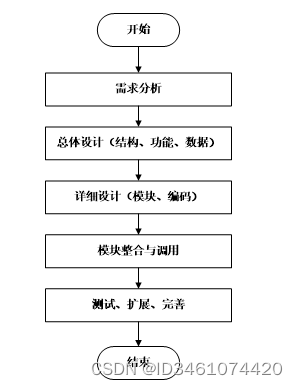
Figure 3-1 System development flow chart
3.2.2 User login process
In order to ensure the security of the system, if you want to use this system to manage system information, you must first log in to the system. As shown in Figure 3-3.
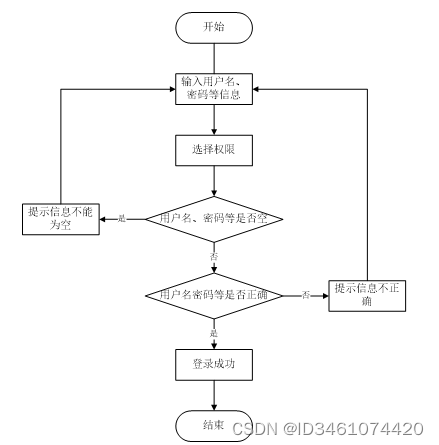
Figure 3-2 Login flow chart
3.2.3 System operation process
After the user opens and enters the system, the login interface will be displayed first, and the correct user name and password will be entered. The system will automatically detect the information. If the information is correct, the user will enter the system function interface and perform operations. Otherwise, an error will be displayed and the user cannot log in. The operation process is as follows As shown in Figure 3-3.
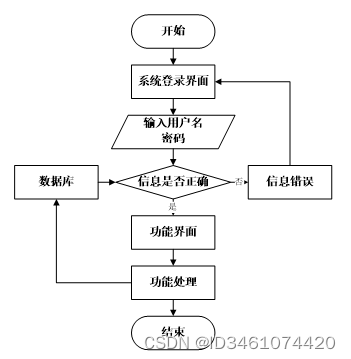
Figure 3-3 System operation flow chart
3.2.4 Add information process
Administrators can add information to the venue center management , and other users can also add information within their own authority. After entering the information, the system will verify the entered information and data on its own. If the information is correct, it will be added to the database. , if the information is incorrect, you will be prompted to re-enter the information. The process of adding information is shown in Figure 3-4.

Figure 3-4 Add information flow chart
3.2.5 Modify information flow
Administrators can modify information for sports venue management , and other users can also modify information within their own authority. First, enter the modification information interface and enter the modification information data. The system will judge and verify the data. If the modified information is legal, the modification will be successful. The information is updated to the database. If the information is illegal, the modification fails and needs to be re-entered. The modified information flow chart is shown in Figure 3-5.
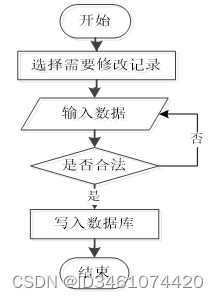
Figure 3-5 Modify information flow chart
3.2.6 Information deletion process
The administrator can delete venue reservation management . After selecting the information to be deleted, click the delete button. The system will ask if you are sure. If you click OK, the system will delete the selected information and delete the information in the database. , the deletion information flow chart is shown in Figure 3-6.
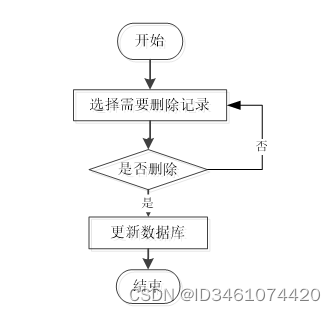
Figure 3-6 Deletion information flow chart
3.3 System use case analysis
3.3.1 Administrator use case diagram
The core user in the system is the administrator . After the administrator logs in, he manages the backend system through the administrator function . The main functions are: homepage, personal information, public management (carousel, announcement information) user management (administrators, faculty, student users, ordinary users) venue center, employee orders, student orders, order information, equipment information, finance Information and other functions . The administrator use case is shown in Figure 3-7 .
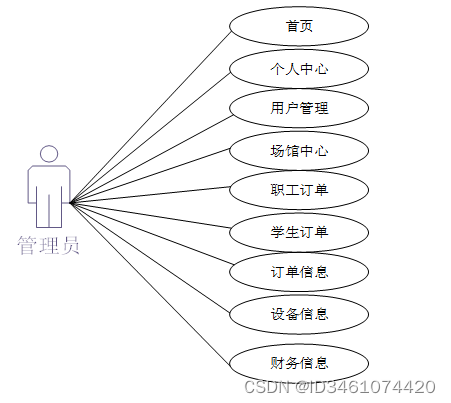
Figure 3-7 Administrator use case diagram
3.3.2 User use case diagram
Users include : home page, announcement information, venue center and other functions. The user use case is shown in Figure 3-8 .
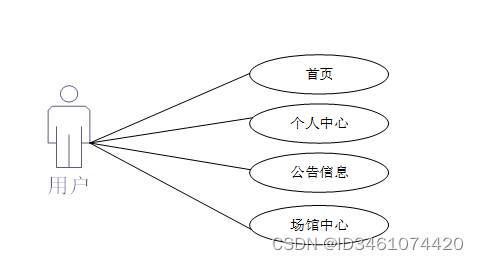
Figure 3-8 User use case diagram
4 System design
4.1 System Overview
After the system analysis, we begin to memorize system design. System design includes overall design and detailed design. The overall design is just a general design. After the overall design, we can divide some things of the system, such as files, documents, data, etc. And through the overall design, we can roughly divide the modules and functions of the program. But it is only a preliminary classification and has no real implementation.
The overall design is just a preliminary design. Moreover, for a project, we can carry out multiple overall designs. Through comparison, including performance comparison, cost comparison, and benefit comparison, we can finally determine an optimal design plan and choose the best one. The overall design can reduce development costs and increase company benefits. From this point of view, the overall design is still very important.
The working principle diagram of the university sports venue reservation system is shown in Figure 4-1:
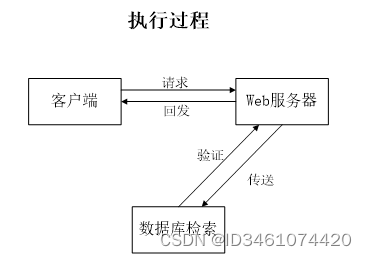
Figure 4-1 System working principle diagram
4.2 System structure design
The system architecture diagram belongs to the system design stage. The system architecture diagram is only a product of this stage. The overall architecture of the system determines the model of the entire system and is the foundation of the system. The overall structural design of the university stadium reservation system is shown in Figure 4-2.
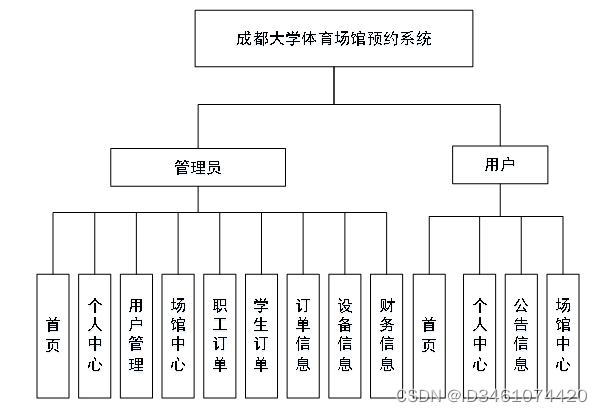
Figure 4-2 System structure diagram
4.3 Database design
Database is the basis of computer information system. At present, the key and core part of the computer system is the database. The quality of database development has a direct impact on the quality and speed of the entire system.
4.3.1 Database design principles
The conceptual structure design of the database adopts the entity-relationship (ER) model design method. The constituent elements of the ER model method are: entities, attributes, and relationships. The ER model is represented by an ER diagram, which reminds the user of things involved in the work environment, and attributes are descriptions of entity characteristics. The database plays a decisive factor in system design. The entity-relationship diagram of these key entities is designed below .
4.3.2 Database entities
Entities in the data model, also called instances, correspond to "events" or "things" that can be distinguished from other objects in the real world. For example, every employee in your company, every piece of furniture in your home.
The ER diagram of this system is shown below:
1. The entity diagram of sports venue management is shown in Figure 4-3:
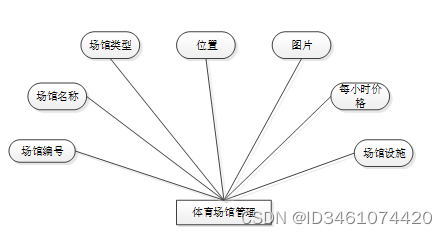
Figure 4-3 Sports venue management entity diagram
2. The user management entity diagram is shown :
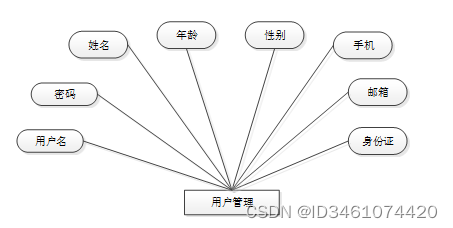
Figure 4-4 User management entity diagram
3. The entity diagram of venue reservation management is shown in Figure 4-5 :
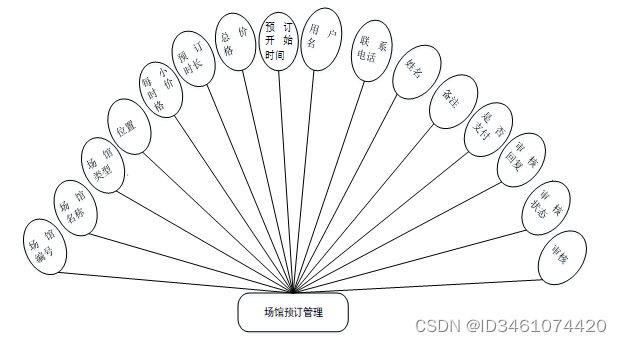
Figure 4-5 Venue booking management entity diagram
4.3.3 Database table design
The table information of the database is part of the design. The detailed information of each table in the database is introduced below.
Table name: config
Function: Configuration file
| device_information |
|||||
| Field Name |
type |
length |
not null |
primary key |
Field description |
| device_information_id |
int |
11 |
yes |
primary key |
Device information ID |
| venue_name |
varchar |
64 |
no |
Venue name |
|
| equipment_name |
varchar |
64 |
no |
Device name |
|
| equipment_status |
varchar |
64 |
no |
device status |
|
| device_details |
longtext |
0 |
no |
Device details |
|
| recommend |
int |
11 |
yes |
Intelligent Recommendation |
|
| create_time |
datetime |
0 |
yes |
creation time |
|
| update_time |
timestamp |
0 |
yes |
Update time |
|
| employee_order |
|||||
| Field Name |
type |
length |
not null |
primary key |
Field description |
| employee_order_id |
int |
11 |
yes |
primary key |
Employee order ID |
| order_number |
varchar |
64 |
no |
order number |
|
| venue_no |
varchar |
64 |
no |
Venue number |
|
| venue_name |
varchar |
64 |
no |
Venue name |
|
| order_date |
date |
0 |
no |
order date |
|
| employee_user |
int |
11 |
no |
Staff user |
|
| unit_price_of_employees |
int |
11 |
no |
Price per employee |
|
| order_quantity |
varchar |
64 |
no |
Order quantity |
|
| hours |
int |
11 |
no |
hours |
|
| order_amount |
varchar |
64 |
no |
order amount |
|
| remarks |
varchar |
64 |
no |
Remark |
|
| examine_state |
varchar |
16 |
yes |
Approval Status |
|
| examine_reply |
varchar |
16 |
no |
moderation reply |
|
| pay_state |
varchar |
16 |
yes |
Payment status |
|
| pay_type |
varchar |
16 |
no |
Payment type: WeChat, Alipay, online banking |
|
| recommend |
int |
11 |
yes |
Intelligent Recommendation |
|
| create_time |
datetime |
0 |
yes |
creation time |
|
| update_time |
timestamp |
0 |
yes |
Update time |
|
| faculty |
|||||
| Field Name |
type |
length |
not null |
primary key |
Field description |
| faculty_id |
int |
11 |
yes |
primary key |
Staff ID |
| employee_id |
varchar |
64 |
no |
Employee ID number |
|
| name_of_employee |
varchar |
64 |
no |
Employee name |
|
| examine_state |
varchar |
16 |
yes |
Approval Status |
|
| recommend |
int |
11 |
yes |
Intelligent Recommendation |
|
| user_id |
int |
11 |
yes |
User ID |
|
| create_time |
datetime |
0 |
yes |
creation time |
|
| update_time |
timestamp |
0 |
yes |
Update time |
|
| financial_information |
|||||
| Field Name |
type |
length |
not null |
primary key |
Field description |
| financial_information_id |
int |
11 |
yes |
primary key |
Financial Information ID |
| income |
int |
11 |
no |
income |
|
| expenditure |
int |
11 |
no |
expenditure |
|
| profit |
varchar |
64 |
no |
profit |
|
| statistical_date |
date |
0 |
no |
Statistics date |
|
| recommend |
int |
11 |
yes |
Intelligent Recommendation |
|
| create_time |
datetime |
0 |
yes |
creation time |
|
| update_time |
timestamp |
0 |
yes |
Update time |
|
| order_information |
|||||
| Field Name |
type |
length |
not null |
primary key |
Field description |
| order_information_id |
int |
11 |
yes |
primary key |
Order information ID |
| order_number |
varchar |
64 |
no |
order number |
|
| venue_no |
varchar |
64 |
no |
Venue number |
|
| venue_name |
varchar |
64 |
no |
Venue name |
|
| order_date |
date |
0 |
no |
order date |
|
| subscriber |
int |
11 |
no |
Subscriber |
|
| usual_unit_price |
int |
11 |
no |
Usual unit price |
|
| order_quantity |
varchar |
64 |
no |
Order quantity |
|
| hours |
int |
11 |
no |
hours |
|
| order_amount |
varchar |
64 |
no |
order amount |
|
| remarks |
varchar |
64 |
no |
Remark |
|
| examine_state |
varchar |
16 |
yes |
Approval Status |
|
| examine_reply |
varchar |
16 |
no |
moderation reply |
|
| pay_state |
varchar |
16 |
yes |
Payment status |
|
| pay_type |
varchar |
16 |
no |
Payment type: WeChat, Alipay, online banking |
|
| recommend |
int |
11 |
yes |
Intelligent Recommendation |
|
| create_time |
datetime |
0 |
yes |
creation time |
|
| update_time |
timestamp |
0 |
yes |
Update time |
|
| student_order |
|||||
| Field Name |
type |
length |
not null |
primary key |
Field description |
| student_order_id |
int |
11 |
yes |
primary key |
Student Order ID |
| order_number |
varchar |
64 |
no |
order number |
|
| venue_no |
varchar |
64 |
no |
Venue number |
|
| venue_name |
varchar |
64 |
no |
Venue name |
|
| order_date |
date |
0 |
no |
order date |
|
| student_users |
int |
11 |
no |
student user |
|
| student_unit_price |
int |
11 |
no |
Student unit price |
|
| order_quantity |
varchar |
64 |
no |
Order quantity |
|
| hours |
int |
11 |
no |
hours |
|
| order_amount |
varchar |
64 |
no |
order amount |
|
| remarks |
varchar |
64 |
no |
Remark |
|
| examine_state |
varchar |
16 |
yes |
Approval Status |
|
| examine_reply |
varchar |
16 |
no |
moderation reply |
|
| pay_state |
varchar |
16 |
yes |
Payment status |
|
| pay_type |
varchar |
16 |
no |
Payment type: WeChat, Alipay, online banking |
|
| recommend |
int |
11 |
yes |
Intelligent Recommendation |
|
| create_time |
datetime |
0 |
yes |
creation time |
|
| update_time |
timestamp |
0 |
yes |
Update time |
|
| student_users |
|||||
| Field Name |
type |
length |
not null |
primary key |
Field description |
| student_users_id |
int |
11 |
yes |
primary key |
Student User ID |
| student_no |
varchar |
64 |
no |
student number |
|
| student_name |
varchar |
64 |
no |
student name |
|
| examine_state |
varchar |
16 |
yes |
Approval Status |
|
| recommend |
int |
11 |
yes |
Intelligent Recommendation |
|
| user_id |
int |
11 |
yes |
User ID |
|
| create_time |
datetime |
0 |
yes |
creation time |
|
| update_time |
timestamp |
0 |
yes |
Update time |
|
| venue_center |
|||||
| Field Name |
type |
length |
not null |
primary key |
Field description |
| venue_center_id |
int |
11 |
yes |
primary key |
Venue center ID |
| venue_no |
varchar |
64 |
no |
Venue number |
|
| venue_name |
varchar |
64 |
no |
Venue name |
|
| cover |
varchar |
255 |
no |
cover |
|
| number_of_venues |
int |
11 |
no |
Number of venues |
|
| unit_price_of_employees |
int |
11 |
no |
Price per employee |
|
| student_unit_price |
int |
11 |
no |
Student unit price |
|
| usual_unit_price |
int |
11 |
no |
Usual unit price |
|
| venue_introduction |
longtext |
0 |
no |
Venue introduction |
|
| recommend |
int |
11 |
yes |
Intelligent Recommendation |
|
| create_time |
datetime |
0 |
yes |
creation time |
|
| update_time |
timestamp |
0 |
yes |
Update time |
|
5 system interface implementation
5.1 Administrator login
The administrator enters a personal username , password and role to log in to the system. At this time, the system's database will search for relevant information. If the username , password and role we enter are incorrect, the database will prompt an error message. , and at the same time, the administrator will be prompted to re-enter his or her user name , password , and role . After the account and password are successfully entered, a successful login message will be displayed. The website administrator login rendering is shown in Figure 5-1:
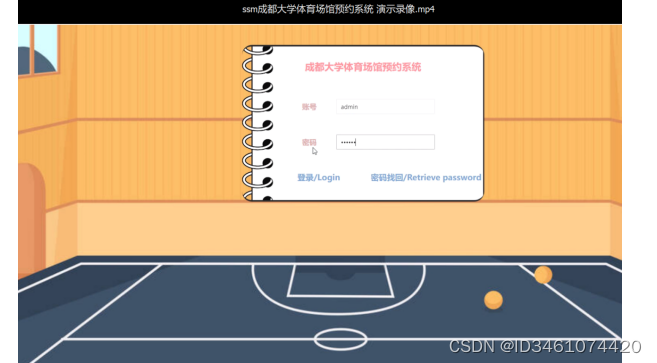
Figure 5-1 Administrator login interface
The login code is as follows:
/**
* Log in
* @param data
* @param httpServletRequest
* @return
*/
@PostMapping("login")
public Map<String, Object> login(@RequestBody Map<String, String> data, HttpServletRequest httpServletRequest) {
log.info("[Execute login interface]");
String username = data.get("username");
String email = data.get("email");
String phone = data.get("phone");
String password = data.get("password");
List resultList = null;
QueryWrapper wrapper = new QueryWrapper<User>();
Map<String, String> map = new HashMap<>();
if(username != null && "".equals(username) == false){
map.put("username", username);
resultList = service.selectBaseList(service.select(map, new HashMap<>()));
}
else if(email != null && "".equals(email) == false){
map.put("email", email);
resultList = service.selectBaseList(service.select(map, new HashMap<>()));
}
else if(phone != null && "".equals(phone) == false){
map.put("phone", phone);
resultList = service.selectBaseList(service.select(map, new HashMap<>()));
}else{
return error(30000, "Account or password cannot be empty");
}
if (resultList == null || password == null) {
return error(30000, "Account or password cannot be empty");
}
//Determine whether there is this user
if (resultList.size()<=0){
return error(30000,"用户不存在");
}
User byUsername = (User) resultList.get(0);
Map<String, String> groupMap = new HashMap<>();
groupMap.put("name",byUsername.getUserGroup());
List groupList = userGroupService.selectBaseList(userGroupService.select(groupMap, new HashMap<>()));
if (groupList.size()<1){
return error(30000,"用户组不存在");
}
UserGroup userGroup = (UserGroup) groupList.get(0);
//查询用户审核状态
if (!StringUtils.isEmpty(userGroup.getSourceTable())){
String res = service.selectExamineState(userGroup.getSourceTable(),byUsername.getUserId());
if (res==null){
return error(30000,"用户不存在");
}
if (!res.equals("已通过")){
return error(30000,"该用户审核未通过");
}
}
//查询用户状态
if (byUsername.getState()!=1){
return error(30000,"用户非可用状态,不能登录");
}
String md5password = service.encryption(password);
if (byUsername.getPassword().equals(md5password)) {
// 存储Token到数据库
AccessToken accessToken = new AccessToken();
accessToken.setToken(UUID.randomUUID().toString().replaceAll("-", ""));
accessToken.setUser_id(byUsername.getUserId());
tokenService.save(accessToken);
// 返回用户信息
JSONObject user = JSONObject.parseObject(JSONObject.toJSONString(byUsername));
user.put("token", accessToken.getToken());
JSONObject ret = new JSONObject();
ret.put("obj",user);
return success(ret);
} else {
return error(30000, "账号或密码不正确");
}
}
public String select(Map<String,String> query,Map<String,String> config){
StringBuffer sql = new StringBuffer("select ");
sql.append(config.get(FindConfig.FIELD) == null || "".equals(config.get(FindConfig.FIELD)) ? "*" : config.get(FindConfig.FIELD)).append(" ");
sql.append("from ").append("`").append(table).append("`").append(toWhereSql(query, "0".equals(config.get(FindConfig.LIKE))));
if (config.get(FindConfig.GROUP_BY) != null && !"".equals(config.get(FindConfig.GROUP_BY))){
sql.append("group by ").append(config.get(FindConfig.GROUP_BY)).append(" ");
}
if (config.get(FindConfig.ORDER_BY) != null && !"".equals(config.get(FindConfig.ORDER_BY))){
sql.append("order by ").append(config.get(FindConfig.ORDER_BY)).append(" ");
}
if (config.get(FindConfig.PAGE) != null && !"".equals(config.get(FindConfig.PAGE))){
int page = config.get(FindConfig.PAGE) != null && !"".equals(config.get(FindConfig.PAGE)) ? Integer.parseInt(config.get(FindConfig.PAGE)) : 1;
int limit = config.get(FindConfig.SIZE) != null && !"".equals(config.get(FindConfig.SIZE)) ? Integer.parseInt(config.get(FindConfig.SIZE)) : 10;
sql.append(" limit ").append( (page-1)*limit ).append(" , ").append(limit);
}
log.info("[{}] - 查询操作,sql: {}",table,sql);
return sql.toString();
}
public List selectBaseList(String select) {
List<Map<String,Object>> mapList = baseMapper.selectBaseList(select);
List<E> list = new ArrayList<>();
for (Map<String,Object> map:mapList) {
list.add(JSON.parseObject(JSON.toJSONString(map),eClass));
}
return list;
}
5.2 管理员功能模块
5.2.1 个人信息
管理员对个人信息进行编辑填写用户名并进行详情、删除、修改等操作。程序成效图如下图5-2所示:
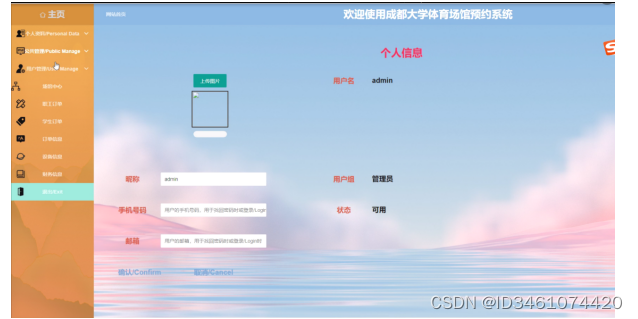
图5-2个人信息界面图
5.2.2 用户管理
管理员对用户管理进行编辑用户名、密码、姓名、年龄、性别、手机、邮箱、身份证等信息并可以进行详情、删除、修改操作。程序效果图如下图5-3所示:
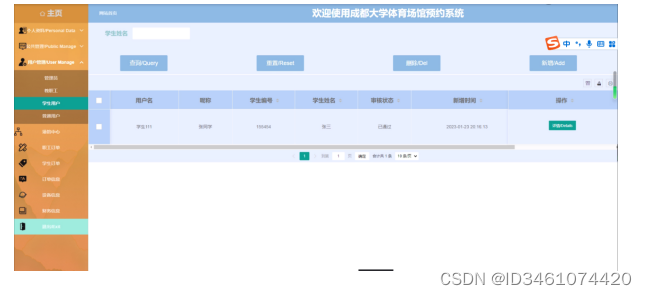
图5-3用户管理界面
5.2.3 场馆中心管理
管理员对场馆中心管理进行编辑场馆编号、场馆名称、封面、场馆数量、职工单价、学生单价等信息并可以进行删除、修改操作。程序效果图如下图5-4所示:

图5-4场馆中心管理界面
5.2.4 轮播图管理
轮播图;该页面为轮播图管理界面。管理员可以在此页面进行首页轮播图的管理,通过新建操作可在轮播图中加入新的图片,还可以对以上传的图片进行修改操作,以及图片的删除操作。程序效果图如下图5-5所示:
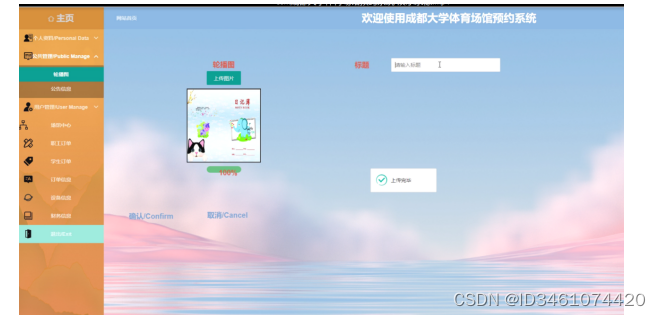
图5-5轮播图管理界面
5.2.5职工订单管理
管理员对职工订单管理进行填写订单号、场馆编号、场馆名称、订单日期、职工用户、职工单价、定订数量、小时数、订单金额、备注等进行详情、删除、修改操作。程序效果图如下图5-6所示:

图5-6职工订单管理界面
5.2.6设备信息管理
管理员对设备信息管理进行编辑场馆名称、设备名称、设备状态、设备详情等信息并可以进行详情、删除、修改操作。程序效果图如下图5-7所示:
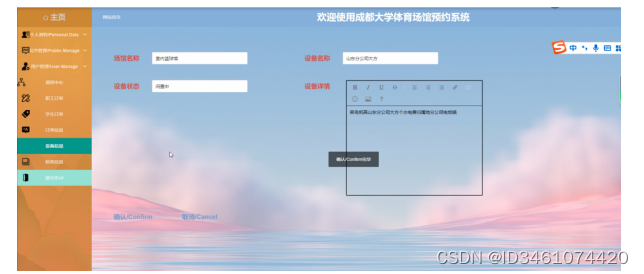
图5-7设备信息管理界面
5.2.7财务信息管理
管理员对财务信息管理进行编辑收入、支出、利润、统计日期等信息并可以进行详情、删除、修改操作。程序效果图如下图5-8所示:
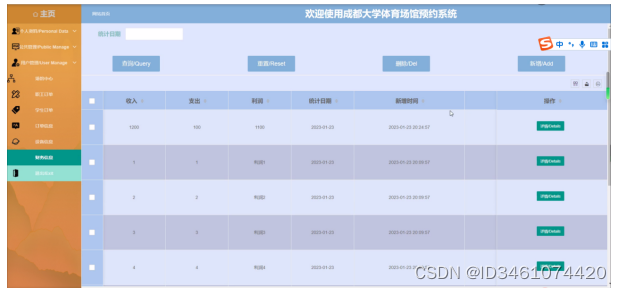
图5-8财务信息管理界面
5.3 前台首页功能模块
前台首页详情页面:首页、公告信息、场馆中心、后台管理等功能操作。程序效果图如下图5-9所示:

图5-9前台首页功能界面
5.3.1 用户登录、用户注册
用户在线填写用户名、密码、姓名、手机、邮箱、身份证等信息进行注册、登录操作。程序效果图如下图5-10所示:
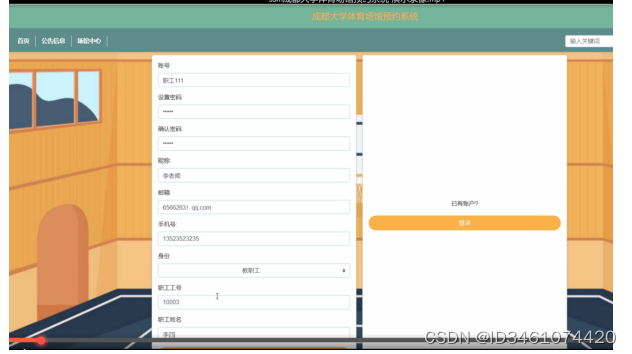
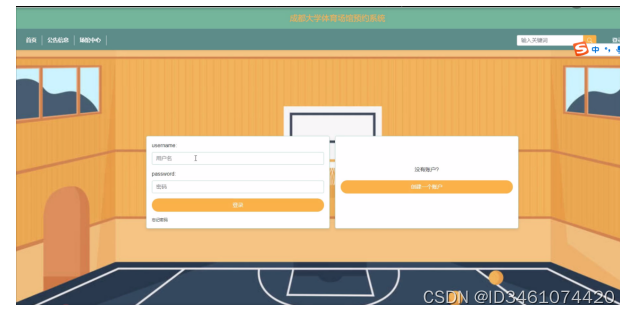
图5-10用户登录、用户注册界面
5.3.2场馆中心
用户进入场馆中心可以查看、场馆名称、场馆类型、位置、图片、每小时价格、场馆设施等信息,并可以进行预约下单、点我收藏操作。程序效果图如下图5-11所示:

图5-11场馆中心界面
5.3.3场馆下单
用户进入场馆中心可以填写场馆编号、场馆名称、场馆类型、位置、每小时价格、预订时长、总价格、预订开始时间、用户名、联系电话、姓名、备注进行提交操作。程序效果图如下图5-12所示:
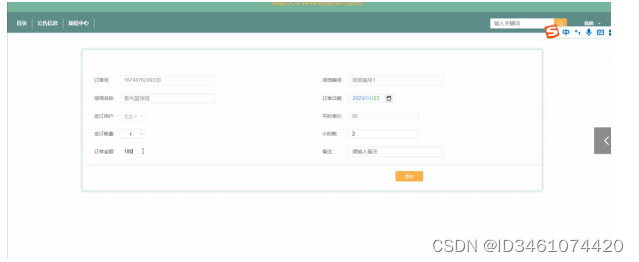
图5-12场馆下单界面
6系统测试
系统开发的最后一个步骤就是系统测试,系统测试也是整个系统十分重要的一个环节,测试的好坏关系到产品的发展。用户对软件的质量、性能和可靠性等需求就要通过测试来实现。测试过程要必须遵循严谨性、完善性、规范性的原则,测试的主要目的就是看看在系统运行中,是否会出现bug,然后对出现的bug进行调试,直到程序完美运行。但是软件的测试只能尽可能的减少bug,理论上来说是无法达到消除bug。但是bug越少,系统出错的几率就越低,用户使用起来也更方便、更安全。
近年来,软件包含测试从现在的检验当中来看,系统接近预期目标可能出现的问题,并对这些错误做出相应的修正,假如我们不进行早期的测试错误就会延续下去,最后所做出的成品就会有很大的困难。
我们要在这个测试的过程当中找出错误。测试成软件开发的主要一部分,自从有了程序的设计那天开始,它就成为了重要的组成部分。经过统计来看,软件测试可以占据这个系统45%的工作量,而在软件开发的成本当中,对于测试成本来说它包含了很多的测试工作。每个程序测试时都会出现和遇到错误。在整个程序的开发过程当中,人为去查找错误是非常复杂和困难的,所以我们一般都会找一些测试的工具来进行测试。
6.1系统测试的意义
随着现代信息的快速发展,在社会各大领域中已经都开始应用网络信息技术,在应用网络技术的同时人们也开始把软件的质量问题作为了一个重要焦点来关注,因为一个软件的好与坏它决定着这个系统在市场上的生存,所以我们必须要把软件质量来做好,这样才有一定的生存能力。对于用户来说它们首先选用的都是保证这个系统软件的质量问题,因为一个系统的软件质量决定着用户在后期上成本经济的问题。图6-1就是纠错测试流程。

图6-1 测试与纠错信息流程
6.2 测试方法
黑盒测试又被人们称作为功能测试,通常是在程序的接口来做一些测试的方法,它一般包括对程序的功能和使用的方法来做出一些数据的接受和输出,同时还可以做出正确的输出信息,并保证与外部信息的完整性。
白盒测试通常被人们称作为结构测试,在整个程序的结构和处理当中它是由程序当中的逻辑测试和检验程序来完成一些正确的工作。
具体的功能测试它是包括:系统的适用性、准确性、安全性等功能测试。
6.3测试分析
本大学体育场馆预约系统满足相关信息的管理需求,在设计时借鉴了国内外优秀网站的优点,从界面到系统设计都保证了管理员以及用户能够方便操作。系统的主要特点和优点归纳如下:
(1)本系统用的移置性和针对性都比较高,因为针对性高可以提供更好的服务而移置性可以在多个系统上运行,更给用户带来了极大的方便。
(2)该大学体育场馆预约系统内容全面,管理方便可以及时的全面的处理各种错误,异常,这样避免了很多因用户的马虎操作而出现的失误,其操作方便,用户界面友好,能够上网的人都可以很好的进行操作。
经过对上述的测试结果分析,所有基本功能齐全,操作简单,系统运行性能良好,系统安全可靠,能促进大学体育场馆预约系统的发展,发展前景广阔。
结 论
本系统通过对Java和Mysql数据库的简介,从硬件和软件两反面说明了大学体育场馆预约系统的可行性,本文结论及研究成果如下:实现了Java与Mysql相结合构建的成都大学体育场馆预约系统,网站可以响应式展示。通过本次大学体育场馆预约系统的研究与实现,我感到学海无涯,学习是没有终点的,而且实践出真知,只有多动手才能尽快掌握它,经验对系统的开发非常重要,经验不足,就难免会有许多考虑不周之处。比如要有美观的界面,更完善的功能,才能吸引更多的用户。
由于在此之前对于Java知识没有深入了解,所以从一开始就碰到许多困难,例如一开始的页面显示不规范、数据库连接有问题已经无法实现参数的传递等等,不过通过在网上寻找有关资料以及同学的帮助下最后都得到了解决,在此过程中,我不仅学到了很多知识,也提高了自己解决问题的能力,尤其是学会如何从大量的信息中筛选出所需有用的信息,同时我更加深刻的体会到了,虽然书本上的大部分知识都是有价值,正确的,但实际上每个人编程的思路和对数据处理的方法、思想都是不同的,这就要求我们一定要通过实践才能找到解决问题的方案。在此次毕业设计活动中,我不断的提高了自己,也得到了宝贵的经验,我相信这些对我以后的发展都会有很大帮助。
通过这次大学体育场馆预约系统的开发,我参考了很多相关系统的例子,取长补短,吸取了其他系统的长处,逐步对该系统进行了完善,但是该系统还是有很多的不足之处,有待以后进一步学习。
实践证明,成都大学体育场馆预约系统有着非常好的发展前景,经过测试运行,系统各项功能都十分完善,界面漂亮,使用方便,操作容易,在技术理论上已经成熟。
致 谢
大学的学习生活在这个季节将结束,但是在我的生命这仅仅只是一个逗号,我将面对另一个新环境的开始。通过这次毕业设计的整个开发过程,从需求分析到具体功能实现,再到最终测试和维护的理解有了很大的进步,让我对系统开发有了更深刻的认识,对我个人的实践能力和解决问题的能力,都有了很大的帮助。这是这次毕业设计最大的收获。
首先要感谢我的指导老师,他在论文写作上,给予了我各种无私的帮助,治学严谨,严格要求,使我获得了很大的收获。老师深厚的理论知识和丰富的实践经验,都深深的影响到我,在这方面,我谨表示衷心的感谢。
其次,我还要对所有的老师和同学表示感谢,他们在我学习的过程中,都积极的提供了很多帮助,无论是专业知识,还是实践操作技能,也能够让我在论文写作中,遇到的一些难题迎刃而解。
最后,对阅读和评审本论文的各位老师表示衷心的感谢!
参考文献
[1]Yusuf Mathiinul Hakim,Risfidian Mohadi,Mardiyanto Mardiyanto,Idha Royani. Ammonium-assisted Intercalation of Java Bentonite as Effective of Cationic Dye Removal[J]. Journal of Ecological Engineering,2022(prepublish).
[2]. USU Software Asset Management is Verified for Data Discovery of JAVA Software[J]. M2 Presswire,2022.
[3]周林,季松华,符欲梅.Java程序设计课程思政探究与实践[J].黑龙江科学,2022,13(19):149-151.
[4]李少芳.基于Java的图片连连看游戏设计研究[J].西安文理学院学报(自然科学版),2022,25(04):59-66.
[5]张晨.Java Web反序列化网络安全漏洞分析[J].四川职业技术学院学报,2022,32(05):158-162+168.DOI:10.13974/j.cnki.51-1645/z.2022.05.021.
[6]任灏榕. 基于J2ME的Java手机游戏开发技巧[J]. 电子技术与软件工程,2019(02):46.
[7]曹文渊. JAVA语言在计算机软件开发中的应用[J]. 电子技术与软件工程,2019(02):53-54.
[8]秦楷. JAVA语言特点及其在计算机软件开发中的运用[J]. 中国新通信,2019,21(01):91.
[9]张之涵,谭霞,温克欢,魏恩伟. 基于Android和Java编程的家庭智能用电管理系统设计[J]. 自动化与仪器仪表,2019(01):121-124.
[10]吴荣珍. 基于JAVA的高职院校人事管理系统设计与实现[J]. 软件导刊,2019,18(01):116-118+123.
[11]陈钟荣,洪滔. 基于Java和聚类分析移动端天气雷达管理系统设计[J]. 现代电子技术,2019,42(02):62-66.
[12]刘昕林,罗伟峰. 基于Java平台的Web应用系统业务性能监测分析[J]. 信息与电脑(理论版),2019(02):67-68.
[13]倪海顺. 计算机软件开发的Java编程语言应用探讨[J]. 信息与电脑(理论版),2019(02):60-61.
[14]党岳雷. 基于Java语言的高校体育信息化APP设计[J]. 微型电脑应用,2019,35(01):119-121.
[15]马寅璞,孔阳坤. 用JAVA实现一个推箱子游戏[J]. 技术与市场,2019,26(02):82-83.
[16]罗超,龙侃. 基于java的企业进销存系统的设计和实现[J]. 信息记录材料,2019,20(02):207-208.
[17]胡彬,田磊. 三维仿真及Java在拖拉机液压零件设计中的应用[J]. 农机化研究,2019,41(03):250-253+258.
[18]程亚维,王东霞. 基于Java的农机作业调度管理Web平台架构技术研究[J]. 农机化研究,2019,41(10):224-228.
[19]段韶鹏,温文豪,轩春青,刘迷. 基于Java的混合数据结构教学演示系统优化设计[J]. 信息与电脑(理论版),2019(01):100-101.
[20]林丽红. 基于JAVA的软件故障自动检测系统设计[J]. 现代电子技术,2019,42(01):183-186.
[21]吴泽智,陈性元,杜学绘,杨智. 基于自动机的Java信息流分析[J]. 计算机应用研究,2019,36(01):246-249+253.
[22]任灏榕. 基于J2ME的Java手机游戏开发技巧[J/OL]. 电子技术与软件工程,2019(02):46[2019-02-28
[23]曹文渊. JAVA语言在计算机软件开发中的应用[J/OL]. 电子技术与软件工程,2019(02):53-54[2019-02-28
[24]吴毅良,罗序良,陆庭辉,郭凤婵. 基于Java和Selenium的自动化操作工具的设计与实现[J]. 机电信息,2019(06):56-57.
[25]王云龙. Java开发一元与二元立木材积自动计算技术[J]. 辽宁林业科技,2018(01):21-28.
请关注点赞+私信博主,免费领取项目源码